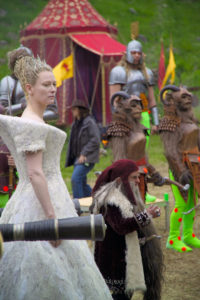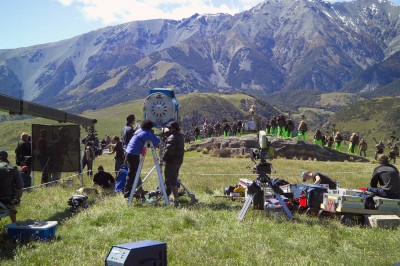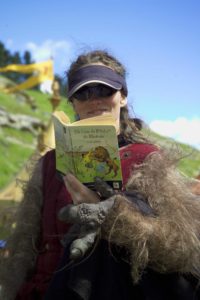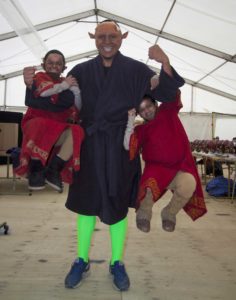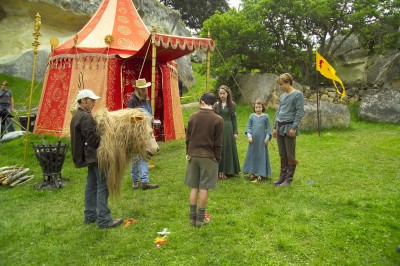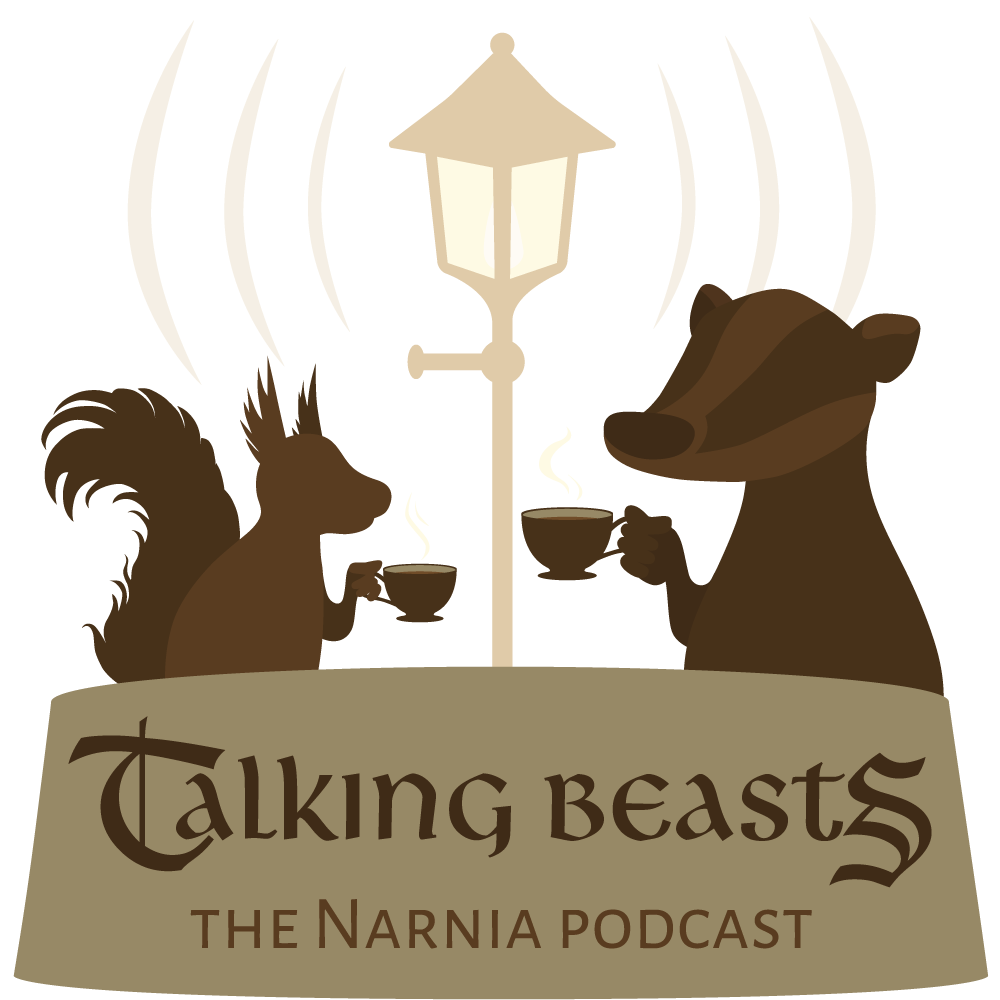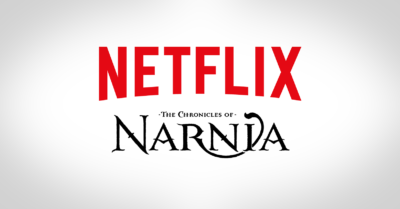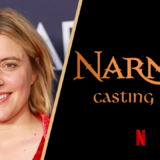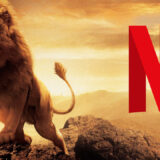Special Interview with Ian Brodie
Our own Shadow-Lander has organized a NarniaWeb exclusive interview with Ian Brodie, the Author and Photographer of Cameras in Narnia. You can also listen to this interview in a NarniaWeb Special Edition Podcast.
Ian has also been kind enough to share with us five never-before-released pictures that he took on the set. We are proud to present these pictures throughout this interview and you can also seem them here in our image gallery. And now, our interview with Ian Brodie:
Shadow-Lander: Hello Ian. Thanks for taking the time to talk to us.
Ian: Sure.
Shadow-Lander: First of all, as can be seen from your website, you’ve had quite a varied background in a lot of different areas. And, I was wondering if you could summarize for us the process that led to you being able to get behind the scenes for The Lion the Witch and the Wardrobe.
Ian: I’ve always had an interest in films since I was a small child, I guess, and the number of films that I went and saw as a teenager really made me want to find out more about how film was made. I was very lucky being a Lord of the Rings fan as well; I was able to write a book on the locations for all of the places in New Zealand for Lord of the Rings. From there I guess, I’d always wanted to explain in simpler terms how, in fact, a film is made. So the idea came up for Cameras in Narnia. It was the logical choice, because that was going to be a big film, it is a big film, great books, and a New Zealand director, being filmed in New Zealand. From there we made approaches with Harper-Collins to publish this, and we also spoke with Disney and Walden, and after some negotiation they agreed, it was fantastic.
Shadow-Lander: Now photography has also been your passion for a long time, as I understand it. How difficult was it to turn that hobby into a profession?
Ian: You’re right, I love photography, and I’ve taken photos for many years as well. It was quite funny on the Narnia set because initially when we made approaches the response was: “No, you are not allowed to take your camera on set, and you are not allowed to take any photos.” So, that created problems for me, I guess, because I knew what I wanted, and I couldn’t think of any other way of getting the images other than taking them myself. I always wanted to point the camera, not at the actors or the stars, so to speak, but in fact the people who were creating the film. But the publicist on the set, Ernie Malik, was fantastic and within two or three days we came to this agreement that ‘Yes, I could take my camera, just stay out of the way, and don’t take any photos while the cameras are rolling.’ Having said all that, taking photos as a profession, I don’t think I’ve actually achieved that yet, because there’s not a lot of money in it, but it sure is great fun! (Laughs)
Shadow-Lander: What was your favorite part of documenting: The Lion the Witch, and the Wardrobe, and how was it different from Lord of the Rings, since you did work on that as well?
Ian: Totally different working on Cameras in Narnia, than Lord of the Rings I guess. Andrew is such a nice guy, and the whole team, some of them had worked on Lord of the Rings as well. It was a very relaxed, casual set. I guess mainly because there were children around, but, everybody just very smoothly did their job, there were no hassles, no loud voices, no yelling, no screaming. Nothing like that at all, and it was just fantastic. I very quickly fitted into that mold, and it was different from Lord of the Rings because I think it wasn’t so many long hours of work on either the people making Narnia. Well, they were working long hours but they were starting at 9:00 (AM), and finishing at about 5:00 (PM) for the children. Less locations, there were only really three major locations outside of the sets in Auckland, so there wasn’t so much traveling either.
Shadow-Lander: So it wasn’t quite as stressful as working on Lord of the Rings.
Ian: Well, I came along on Lord of the Rings after the majority of filming had finished. I was just lucky that I was allowed to hang out on set for about six weeks during pick-ups for Return of the King, so that was great. I had a small bit part in the film and I just kind of hung out, it was great, and it wasn’t so much of a job. Whereas with this one, with Narnia, I obviously had to produce a book at the end of it, and make sure that I had interviewed all of the right people. I came up with a list of about 40 people that I needed to talk to during my time there. When you see the resulting book I’d have to say that’s probably about 10% of the material or the photos that I gave them.
Shadow-Lander: You mentioned a part in Lord of the Rings, what part did you play?
Ian: (Laughs) Both my son and myself were in Return of the King. I’m a Gondorian Bread Seller, in Minas Tirith when Gandalf sends Pippin up to light the beacons, you can see me in the background. My son is an Orc, marching out of Minas Morgul when they are coming across to take Minas Tirith.
Shadow-Lander: Oh wow.
Ian: A part of history. (Laughing)
Shadow-Lander: That sounds like fun.
Ian: It was fun, and I’ve been a fan of Lord of the Rings and Narnia for the last 30 odd years, so, to be a part of history in two wonderful films like The Lion, the Witch and the Wardrobe, and Lord of the Rings is just fantastic, it’s a real honor.
Shadow-Lander: So, you were familiar with The Lion the Witch and the Wardrobe before it was filmed?
Ian: Oh yeah, I’ve read the books. I have to say, I love Tolkien, I love Lord of the Rings, and I read them over and over and over again. I love the in depth geography, history that Tolkien could bring across. But, I loved Narnia; I love the whole series in a different way, I guess. It was more a fantasy book that left a lot more to your imagination than Tolkien did. But, as I grew up and got older, I was so intrigued by the fact that C.S. Lewis and J.R.R. Tolkien used to drink together, and talk together, and discuss things together. Did they talk about Narnia and Middle Earth? What were their discussions? I find that fascinating.
Shadow-Lander: What can you tell us about what your typical day was like on the set?
Ian: Well I would normally get up at about 5:30 and I would make sure I was at the set about 7:00. And again, Ernie Malik was fantastic. He had a list of the people that he knew I needed to talk to, so depending on what was happening that day, he teed up a few interviews for me. But to be honest, the majority of the day would be sitting literally over the shoulder of Andrew or sitting, watching people setting up something to be filmed and being given free access, allowed to wander anywhere and making sure I didn’t stand on the groomed grass. It was so much of a job getting that beautiful green grass back up at Flock Hill and of course at Elephant Rock. K.C. the first A.D., he had the loudest voice and he was always the one that would scream “Get off that grass!” But literally I would just wander around and sit down somewhere and be very polite and take photos. I took about 3,500 images. Again digital photography has been fantastic for me. I used a 14 megapixel camera and I found by the end of the day I probably rattled off a number of images obviously so most of the night was then spent transferring them from CF cards onto my Mac, making sure I had the images I needed before carrying on the next day.
Shadow-Lander: What was it like to be able to work with Adamson and the children and everyone else involved? What was that whole experience like?
Ian: That’s probably one of the highlights of my life, I’d have to say was working with him. And it’s something I wanted to try and get across in the book is, if you’ve never been on a movie set, it’s very hard to explain in fact what it’s like. It’s such an amazing group of people. You wonder how they actually get the job done because there’s so much to be done in a day, in a week, in a month. They have a plan and they have to stick to their plan. But it’s being involved with them, sitting beside them, watching this creative energy. And that’s creative energy from a director like Andrew who has obviously an overview of exactly what he wants, through to the director of photography who is going to translate what Andrew wants in his mind into something that’s on the screen. The sound man who is going “I know I need to get the sound like this because we are going to mix it this way.” The green screen guys that are making sure that everything is in exactly the right place. The art department working so hard to ensure that the set is correct. It’s just such an amazing set of people. The grips that worked so hard to see how that the camera tricks work smoothly. It sends shivers down the spine even thinking about it now.
Shadow-Lander: Did you get any funny pictures that you weren’t allowed to actually include in the book? Pictures that the production, for one reason or another, didn’t want in print?
Ian: Well I guess one thing I’ve learned being on a film set is discretion. We’ve got to make sure that you only get things which can be used. So in answer to that question, pretty simply no, actually. There was very little like that. I’ve got some great photos of all the guys – all the grips playing this major cricket match with various parts of the set and things like that. But in reality they were all pretty well behaved. (laughter)
Shadow-Lander: Where do you go from here? What are the next projects that you are working on? I know on your website you mention a new book called “A Journey through New Zealand Film” and what can we look forward to in that book?
Ian: Well again, that’s my love of New Zealand combined with my love of New Zealand film and it includes in Narnia in there. It’s a journey through New Zealand film right back to the beginnings, I guess, of what I would call modern film in New Zealand with Sleeping Dogs. The director of that was Roger Donaldson who recently completed The World’s Fastest Indian. He’s written the foreword to the book. So it’s a trip through New Zealand literally from Kaitaia in the North Island right down to the bottom of the South Island with about thirty major New Zealand films, where they were filmed, how to get there, what you can see. It’s a journey off the beaten trail of New Zealand to some fantastic places and at the same time, if I can introduce some people who maybe haven’t seen a lot of New Zealand films, introduce them to that as well.
Shadow-Lander: Now, do you plan on working with Walden on any more of the Chronicles of Narnia?
Ian: Certainly. I’d love to work with Walden, on any other films that they do. That’s something that we’ll just have to wait and see in the future. I’m eagerly waiting to see the results of where Prince Caspian is going to be filmed for example. I’d love to see it back in New Zealand.
Shadow-Lander: Right, that’s definitely a hot topic right now. Everyone’s waiting to see where it’s going to be filmed.
Ian: It sure is, and I’m certainly one of those! I watch your website every day, because you’re the guys who are going to get the news first!
Shadow-Lander: That’s good to hear! Now, do you hang out in our forum at all? Are you active in other parts of the site at all, other than the news?
Ian: I tend to go to the news I’ll have to admit, because it’s a matter of time. Writing film books is a night job for me. I’m a director of an aviation museum during the day. But I must admit, the first thing in the morning when I wake up, what do I do? I go to the internet, I go to NarniaWeb, and then I go to TheOneRing.net and that’s my news for the day. (Laughing) You guys always have the news first.
Shadow-Lander: Well that’s great to hear. We try to always get it first.
Ian: Well, it’s such a wonderful topic, and, again, I’ve been lucky I have to say. Anybody can sit down and write a book, and take a few pictures of a movie set, I guess. I’ve been lucky, and if I can repay the opportunities that I’ve been given by writing good books that get across what it actually, really is like, then that’s part of my job completed as well.
Shadow-Lander: When you write a book, how much of it is watching the filmmakers make a film, and how much of it is watching a story come to life?
Ian: I guess, with Cameras in Narnia, what I did do was sit down with a dictophone and inverview 50-odd people for 30 minutes. Because I wanted the background – I wanted to know what their thoughts and aspirations were. What they wanted to see out of the film. From that, we turned it into simpler text. It was great with The Lion, the Witch, and the Wardrobe because the filming was done pretty much in sequence, so you could follow that story. A lot of films, of course, it’s all over the place. Lord of the Rings, they filmed some Mount Doom scenes before they filmed Hobbiton! So, that was quite confusing, whereas with Cameras in Narnia: The Lion, the Witch, and the Wardrobe, it was the story unfolding. And as the story unfolded, I think the children got to know each other better – the family group – and that was a family group of 500 got to know each other better as well, but again, the wonderful thing was a lot of them had to work together on previous films. So they knew how they worked together.
Shadow-Lander: What did you think of the finished product? When all was said and done, and the final movie was released, what was it like to watch the movie and think “Oh, I remember that day. I remember when they filmed that scene.” What was it like?
Ian: And that’s exactly what it was like. It was funny, because we were lucky enough, my wife and I, to be invited to the New Zealand premiere in Auckland. And from the moment it started, I was on the edge of my seat, I guess. I went “Wow, so that’s how they did that.” “Oh, I remember that part.” I loved it. I cried, I laughed, I did all the things, I guess, I fed off the rest of the audience. Without a doubt, everyone in that civic theater enjoyed every moment of it. I wished it was an hour longer. Lots of little bits that I’d seen filmed that didn’t make the cut. But equally for me, it was the first film that I’d actually been a total fly on the wall on, I guess. I remember so vividly the scene where the children bow down with the good guys in front of Aslan as he comes out of the tent. And I was standing on the camera boom, photographing that as it happened. And just to see the final result with so many green screen, or so much CGI, put in was just unbelievable. To wander ’round – I spent a lot of time up at Kelly Park, wandering through the snow and under the lamppost and into the Beavers’ house and things like that. But to see the end result, to see that wonderful combination of real life filming and computer-generated filming was fantastic.
Shadow-Lander: You mentioned noticing that there were scenes that you had seen filmed that didn’t make the cut. The only scene that we’ve really been aware of, just from what we can see from the trailers and such, is – there was one scene at Cair Paravel – a dancing scene that was filmed and in the trailer, but never actually made it into the movie.
Ian: No, that’s right.
Shadow-Lander: What other scenes are you aware of?
Ian: Well, it was only little bits, I guess. It was, watching the children interacting, talking with each other. Little pieces filmed that didn’t make it. It wasn’t anything major. Certainly nothing in there that went “Oh, I wish that had been in there.” It was just little bits. You just can’t physically, with what we filmed, fit it all in the movie. And I must admit, you might get an idea, I guess, from the book, that I’m a bit of an editing fan as well, and I spent a lot of time with Sim Evan Jones and particularly Jim Mayer, watching them edit the film. And that is such an art in itself, as well, watching – how can you take all of this, and convert it into just this, but get it across exactly right. And they do.
Shadow-Lander: Right. Well, the reason I asked this is that, as you probably know, we recently got a news item about the possibility of an extended edition. I was just wondering if you had known of any scenes that might possibly be in there.
Ian: No, I don’t, I’m afraid. I’ve no idea what that’s going to be, but I’ll be the first to buy it when it comes out.
Shadow-Lander: You’ll have a lot of competition, because I know a lot of people at NarniaWeb are looking forward to it.
Ian: Oh, most definitely! It’s something, and it’s funny, one of the things. I’ve got a DVD collection, maybe 250 movies at home, but it’s the extended ones, it’s behind-the-scenes, it’s those things that I love. I’ve got a lot of “making of” books. In fact, I buy every one, because, again, I just want to see all those little bits – the extra bits, the bits that, maybe, we missed out on. But it’s us fans, and we’ve just got to be so thankful that directors, now, are doing this, and feeding so much more to us fans.
Shadow-Lander: Right. It’s such an amazing experience to be able see with all of the behind-the scenes and also with, like, all the work that you’ve done to see what actually goes on. Because, as an avid Narnia fan myself, it’s really amazing just to be able to see all of the work that goes into making the finished product.
Ian: Oh, and there’s so many people that I think I’d written something in an article for Christianity Today. [Editor’s Note: Click here for that interview at CT.] You know, you watch this rolling credits that seem to go on and on and on, and a lot of people get up and walk out when the credits start rolling, but you’ve just got to look at that huge list of people that worked, in many instances, 6 days a week, 14 hours a day, to achieve something that is exactly right – that is fantastic – and, no, I’m not getting paid by Disney or anybody else to say this, because I loved it. But it’s that huge group of people, and to me, I wanted to get a thank you across to them.
Shadow-Lander: Thank you so much for taking the time to explain this. I’ve really enjoyed it.
Ian: Oh, my pleasure. And I look forward to talking to you again, maybe Prince Caspian or something else that comes along.
If you’re interested in finding out more about Ian Brodie and his work, go to his website at www.ianbrodie.net. We’d like to thank Ian for his time and for sharing with us. Thanks also to Shadow-Lander for running down this great interview and thanks to Rilian, Coraline, and Master Oliver for their work producing and transcribing the interview.

